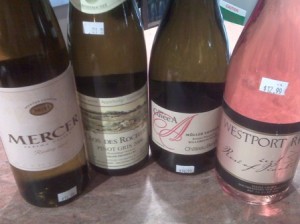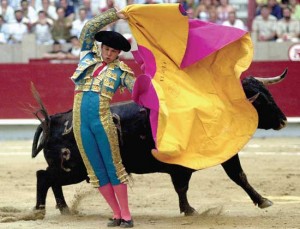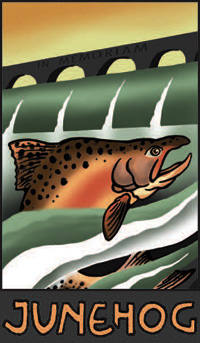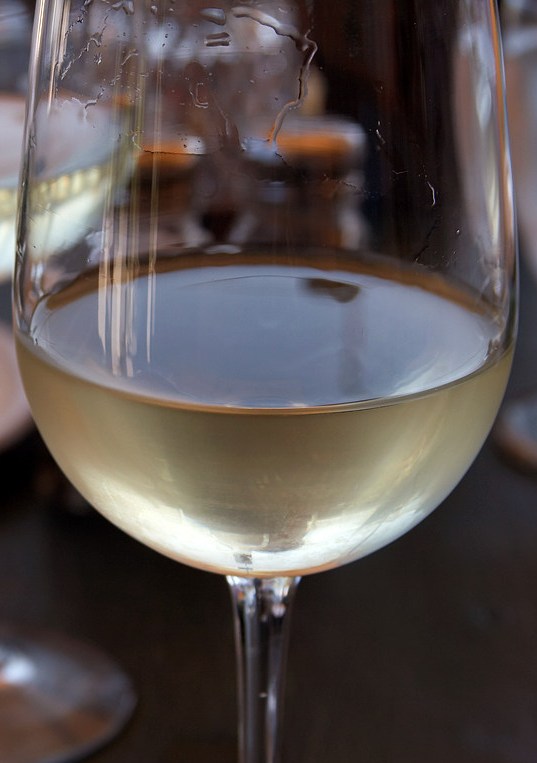 Earlier this week I saw an email thread asking recipients to pick their top wine of the year. I can't think of a more impossible task! If you've been reading the Pour Favor blog for awhile, I'm sure you know exactly why I feel this way: wine is an experience! Without context - friends, family, laughter, tears, food, bistro, bar, fireplace, porch, picnic blanket, a night "in"....- wine is just juice in a fancy bottle, with a special closure. Well, maybe not quite but you get my drift....
Since this will be my last post before the New Year, I've decided to offer a nod to the year past. I'm going to throw out a few wines I've found this year, which are particularly worthy of a good excuse to open, which I've not yet shared. We'll start with white, then red, then bubbly, and then - just for good measure - a dessert wine. Fasten your seat belt! These are a few of my 2008 YUM wines:
Earlier this week I saw an email thread asking recipients to pick their top wine of the year. I can't think of a more impossible task! If you've been reading the Pour Favor blog for awhile, I'm sure you know exactly why I feel this way: wine is an experience! Without context - friends, family, laughter, tears, food, bistro, bar, fireplace, porch, picnic blanket, a night "in"....- wine is just juice in a fancy bottle, with a special closure. Well, maybe not quite but you get my drift....
Since this will be my last post before the New Year, I've decided to offer a nod to the year past. I'm going to throw out a few wines I've found this year, which are particularly worthy of a good excuse to open, which I've not yet shared. We'll start with white, then red, then bubbly, and then - just for good measure - a dessert wine. Fasten your seat belt! These are a few of my 2008 YUM wines:
WHITE: 2007 Les Heritiers du Comte Lafon Macon Milly Lamartine
I've rediscovered my passion for White Burgundy this year, first during the spring and then again and again this fall as it has gotten colder and I still crave a wonderful white. Dominique Lafon has long been revered for producing wonderful, concentrated wines in Meursault. His innovative edge and desire for a challenge brought him to the Maconnais - a region he recognized as under-appreciated, simply needing a bit of TLC. This wine is clear evidence exceptional insight, wine making and viticultural practices yield amazing results. The Les Heritiers has an intensely aromatic bouquet of pear, honeysuckle, citrus and jasmine. Its intoxicating minerality is complemented by rich pear and orange peel flavors. Such vibrancy and complexity is delivered in a memorably mouth-filling package. Delicious!
RED: 2005 O'Shaughnessy Howell Mountain Cabernet Sauvignon
It is rare for me not to write my own wine notes, but in the case of this wine I'm always left speechless (an amazing feat, I know!). Fortunately, the winemaker's notes capture the absolute explosion of well-integrated layers that ravish my taste buds and wrap me in a lovely cocoon of happiness! Ripe cherry, blackberry, smoke, tobacco leaf, coco bean and dark chocolate aromas are framed by sweet vanilla oak. Elegant but concentrated flavors of espresso bean, graphite, raspberry and strawberry preserves are followed by a long complex finish with silky tannins and good acidity. An extracted wine that is rewarding. A worthwhile splurge for Christmas dinner, for sure!
SPARKLING: 2001 Westport Rivers Imperial
This winery proves Massachusetts is capable of producing tremendous wines - and bubbly at that! Just imagine yourself on the Cape, beach book in hand, foaming waves rolling onto the shore and fresh, juicy peaches, pears and apples in the cooler nearby. Add a spritz of sea air and you have the Imperial in your glass. It has a full, frothy mouse of tiny, tiny bubbles that deliver a tremendous, floral nose. Just a touch of citrus is evident on the palate - a welcome crispness to offset its wonderfully lush character. Just a touch of sweet, ripe fruit lingers on the finish. Salud!
DESSERT: 2007 Bouchaine Bouch D'Or Late Harvest
For me, this wine was love at first sip! It is an opulent, seductive dessert wine made of 94% Chardonnay and 5% Riesling - not a late harvest often found. It has an enticingly floral nose, followed by apple fruits layered with honey flavors. A gentle touch of minerality is well-integrated. Not for the lighthearted, this wine is deliciously decadent!
I hope you and yours have a safe, happy and healthy New Year! Be sure to pick up a bottle of something fun this holiday season. And please, share what you've selected!
 Thanksgiving is a time to gather with friends and family and celebrate the little things in life. Some folks are inclined to do so by picking out one very special bottle of wine to share with friends; for others it is a time to uncork several celebratory bottles (and keeping the average price a bit lower doesn’t hurt). Pinot Noir and Gamay (Beaujolais Nuveau) are the darlings of Thanksgiving reds, offering a delicious pairing with turkey and cranberry sauce, brussel sprouts and other earthy, root vegetables. But with the Pour Favor mini-series on Pinot Noir about to hit full stride Monday's this month, it seems only fair to give a few whites (and one incredible rosé) a fair shot at gracing your dining room table!
Head over to Wicked Local to find out where the fun begins this Thanksgiving!
Thanksgiving is a time to gather with friends and family and celebrate the little things in life. Some folks are inclined to do so by picking out one very special bottle of wine to share with friends; for others it is a time to uncork several celebratory bottles (and keeping the average price a bit lower doesn’t hurt). Pinot Noir and Gamay (Beaujolais Nuveau) are the darlings of Thanksgiving reds, offering a delicious pairing with turkey and cranberry sauce, brussel sprouts and other earthy, root vegetables. But with the Pour Favor mini-series on Pinot Noir about to hit full stride Monday's this month, it seems only fair to give a few whites (and one incredible rosé) a fair shot at gracing your dining room table!
Head over to Wicked Local to find out where the fun begins this Thanksgiving!

 Ok. Bad joke. (I can't take full credit as one of my best friends, fellow foodie and wine lover actually fed it to me.) What can I say? Sometimes a little levity is needed!And it was Cinco de Mayo yesterday....
Ok. Bad joke. (I can't take full credit as one of my best friends, fellow foodie and wine lover actually fed it to me.) What can I say? Sometimes a little levity is needed!And it was Cinco de Mayo yesterday....
 If you think of Spain's geography as the shape of a bull's head, you realize it doesn't have much of a western coast. Portugal actually comprises much of that area - with only the tippy-top of Spain's left "bull horn" having ocean boundaries. It is in this northwestern area, Galicia - and perhaps more notably, the D.O. Rias Biaxas (said Ree-as Byay-shas) - where arguably the most versatile white wine is created:
If you think of Spain's geography as the shape of a bull's head, you realize it doesn't have much of a western coast. Portugal actually comprises much of that area - with only the tippy-top of Spain's left "bull horn" having ocean boundaries. It is in this northwestern area, Galicia - and perhaps more notably, the D.O. Rias Biaxas (said Ree-as Byay-shas) - where arguably the most versatile white wine is created:  A few headlines crossing myriad academics, if you will, caught my attention this week. Here's what rose to the top of my reading list:
A few headlines crossing myriad academics, if you will, caught my attention this week. Here's what rose to the top of my reading list:

 I'm cooking a harvest-themed feast for a few friends this year and couldn't be more thankful to avoid the madness of travel including, but not limited to: airport delays; someone else's Aunt Tilda and her generous supply of lipstick and perfume; and the screaming baby in the seat across the aisle. I'm not a Bah Humbug for Christmas, but I've lived through too many challenging Thanksgiving trips to want to head elsewhere for the otherwise great event. An entertaining parade that inspires nostalgia, football (no matter how bizarre the match-up), a feast chock full of friends and good humor and a great bottle of wine (or two or three) are all the ingredients I need for a lovely day of giving thanks.
If you haven't made it to your wine shop to select a bottle of wine this year, today might be a good day to drop by. It will only get trickier to navigate the aisles as mid-week approaches. And if you don't already have a favorite Pinot Gris, Riesling, Beaujolais Villages, or Pinot Noir picked out, remember to consult your shop's wine buyer. There are some fun things on the market this year you won't want to miss. (Two that come to mind are the
I'm cooking a harvest-themed feast for a few friends this year and couldn't be more thankful to avoid the madness of travel including, but not limited to: airport delays; someone else's Aunt Tilda and her generous supply of lipstick and perfume; and the screaming baby in the seat across the aisle. I'm not a Bah Humbug for Christmas, but I've lived through too many challenging Thanksgiving trips to want to head elsewhere for the otherwise great event. An entertaining parade that inspires nostalgia, football (no matter how bizarre the match-up), a feast chock full of friends and good humor and a great bottle of wine (or two or three) are all the ingredients I need for a lovely day of giving thanks.
If you haven't made it to your wine shop to select a bottle of wine this year, today might be a good day to drop by. It will only get trickier to navigate the aisles as mid-week approaches. And if you don't already have a favorite Pinot Gris, Riesling, Beaujolais Villages, or Pinot Noir picked out, remember to consult your shop's wine buyer. There are some fun things on the market this year you won't want to miss. (Two that come to mind are the  White wines aren't just a summer thang. (One of the best turkey wines is actually
White wines aren't just a summer thang. (One of the best turkey wines is actually  In part I'm inspired by last week's discussion on
In part I'm inspired by last week's discussion on